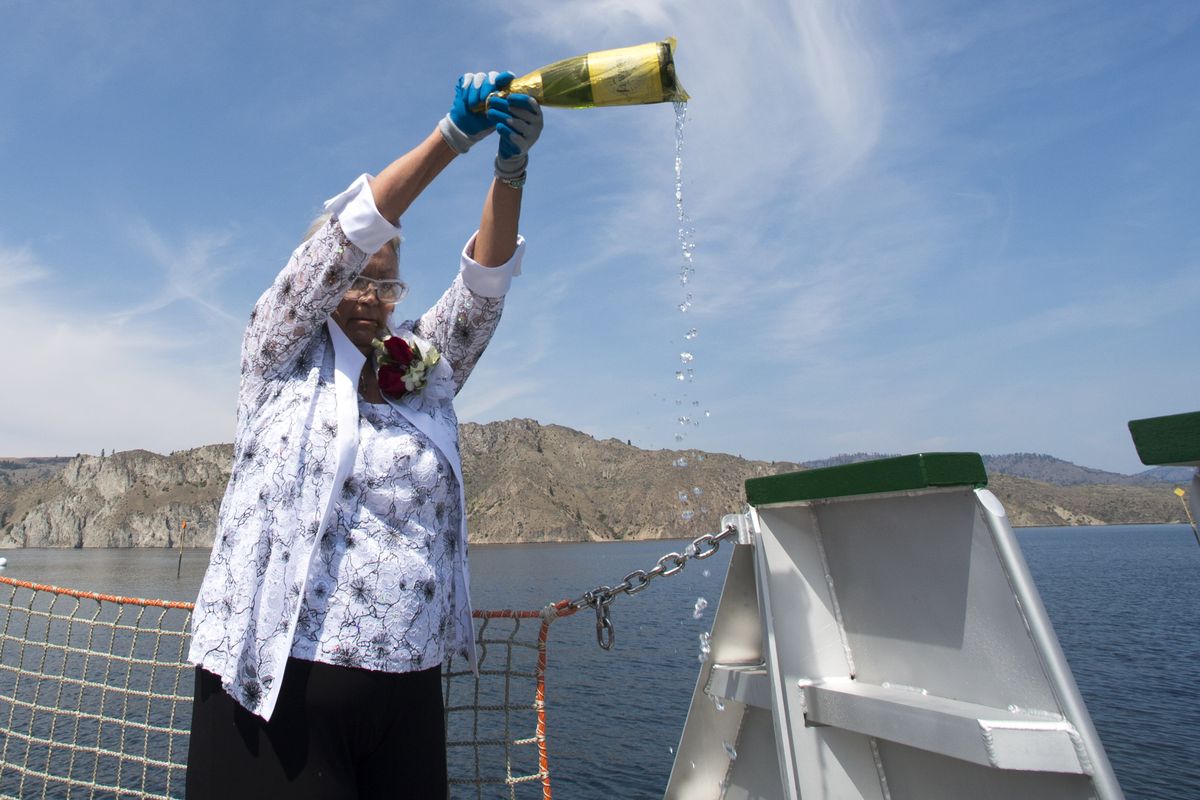High-tech ferry christened on shores of Columbia River
Jeanne Jerred, a community tribal elder of the Sanpoil people, christens the Sanpoil before its maiden voyage across Lake Roosevelt.
KELLER FERRY LANDING – The MV Sanpoil on Wednesday slipped away from her south shore terminal, quietly gliding across the Columbia River on her maiden voyage.
“Ah, this is nice,” said Dolly Brudevold, a teacher at Keller Elementary School and a regular commuter on the 1.5-mile crossing for State Highway 21.
Scores of people lined the bank to witness the ferry’s first official crossing – seven years after state engineers completed its initial design.
“It’s pretty awesome,” said Storey Jackson, who was there with her three children for the occasion.
The $9.5 million Sanpoil replaces the much smaller Martha S., which served the route since 1948 but had to be replaced because of repeated breakdowns and a rusting hull.
While the ferry carries plenty of tourists, her most important job is to keep the region’s communities connected and economy alive, community members said.
The free ferry is expected to carry 60,000 vehicles a year on 30 to 35 crossings a day from 6 a.m. to midnight, connecting Ferry County on the north with Lincoln County on the south.
Wednesday’s festivities began with an official christening that drew more than 200 people to the deck, including dignitaries, Colville tribal members, transportation workers and the public.
“I wish for calm winds and fair waters,” invoked Jeanne Jerred, a member of the area’s indigenous Sanpoil band, just before Jerred took three swings to break a nonalcoholic “champagne” bottle and drip its contents across the spotless deck.
The 116-foot ferry, capable of a peppy 12.5 knots, was built with marine-grade aluminum plate for lower maintenance, no repainting and longer life. It carries up to 20 passenger vehicles or a combination of two semitrucks and nine passenger vehicles.
The Sanpoil is 41 feet longer than the Martha S., which had room for 12 passenger vehicles.
The new ferry meets a U.S. Coast Guard standard of having two hull compartments for stability in case of damage.
Its overhead wheel house is equipped with a radar system that lets pilots set a GPS track for a precise navigation. Power comes from two 450-horsepower diesel engines and two 52-inch propellers.
Foss Maritime Co. in 2011 beat out two other Pacific Northwest competitors for the construction contract.
The hull was built at Foss’ shipyard northwest of Portland and hauled by truck up the Columbia River Gorge and then north to Crescent Bay Park at Grand Coulee, where it was assembled along the beach.
Rick McKenna, of Foss, said the challenges of shipping and assembling the Sanpoil without dock facilities tested the workers’ planning and skill. But the care and craftsmanship that went into the ferry means “she will be plying these waters for a long time,” he said.
The name Sanpoil is given to the indigenous people who inhabited the Sanpoil River Valley that extends north from the Columbia River at the point of the crossing. The Washington state Department of Transportation selected the ferry name to honor the valley’s original inhabitants from more than 500 suggestions submitted by the public.
The crossing was used traditionally by native people. “It is the only gateway to this part of the reservation even before Grand Coulee (Dam) was constructed,” said Michael Finley, chair of the Confederated Tribes of the Colville Reservation.
The tribes contributed $2 million to the project, which totaled $12.5 million including design costs and improvements to the north and south shore terminals. State funding and a federal grant provided the bulk of the funding.
Getting the money approved and the ferry built required a cooperative effort of numerous agencies, including the tribal government, the region’s legislators, federal Bureau of Reclamation, Oregon Department of Transportation, U.S. Army Corps of Engineers, WSDOT and local government agencies, officials said.
Max J. Kuney Co., of Spokane, was the contractor on terminal work.
“It’s been a long voyage to get to this point,” said Keith Metcalf, interim chief engineer for WSDOT.
Sanpoil elder Glen James in a blessing said, “This will be packing our schoolchildren. It will be doing all of these good things for years to come.”

